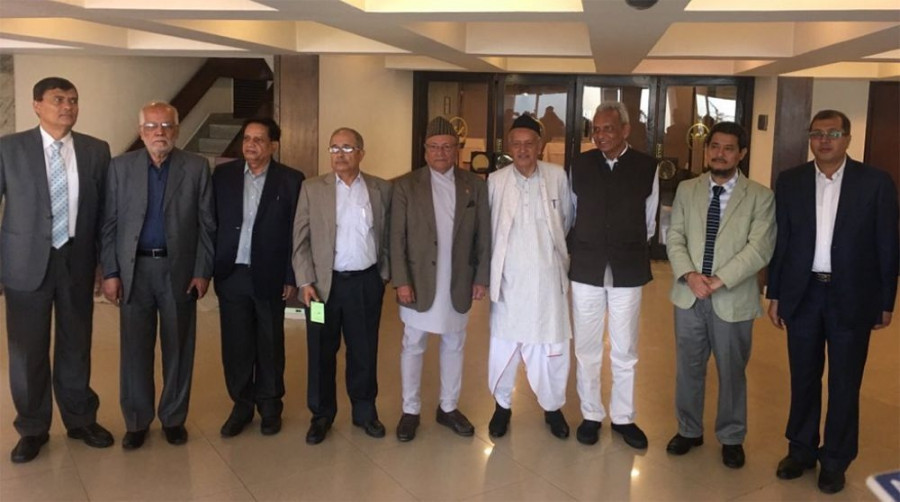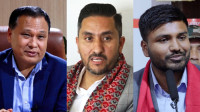National
Ignored for three years, EPG report is losing its relevance
Eminent Persons’ Group, formed to review various aspects of Nepal-India ties, including the 1950 Treaty, finalised the report in July 2018, but it continues to gather dust.
Anil Giri
In the first week of July 2018, the eight-member Eminent Persons’ Group on Nepal-India relations finalised a joint report with various recommendations aimed at redefining the bilateral ties between the two countries. The group consisted of four members each from Nepal and India.
The group, now defunct, has not been able to present its report to the prime ministers of both countries. The group was mandated to review various aspects of bilateral relations, including the 1950 Treaty of Friendship between Nepal and India.
During its more than two years of existence, Nepal has seen four prime ministers—KP Sharma Oli twice—while India has been led by Narendra Modi. The group’s inability to present the report was largely attributed to Modi's “busy” schedule, rather than Nepal’s unwillingness.
After more than three years, questions have arisen about the relevance of the report.
“We could not understand why India was reluctant to receive the report. I do not see any reason for not receiving it as it was prepared jointly by members of both the countries,” said Rajan Bhattarai, who was a member of the group.
The group was headed by Bhekh Bahadur Thapa from the Nepali side with Nilamber Acharya, currently the ambassador to India, Bhattarai, and Surya Nath Upadhyay, former chief commissioner of the Commission for Investigation of Abuse of Authority.
From the Indian side, Bhagat Singh Koshyari headed the group, with Jayant Prasad, former Indian ambassador to Nepal, Mahendra P Lama, a university professor, and BC Upreti, a scholar, as members. Upreti died in December 2018. Koshiyari has been the governor of the Maharashtra state of India since November 2019.
Bhattarai believes the EPG report is still valid, and the context has not changed when it comes to Nepal-India ties.
“During our communication to India, we did not get any sense that they were against receiving the report, but the fact is they have not [accepted it] yet,” Bhattarai, who was the foreign affairs adviser to Oli until last month, told the Post.
The current government led by the Nepali Congress should follow up on the matter, he suggested.
The EPG was formed in January 2016, when Oli was the prime minister. Nepal-India ties at that time had hit a new low in the wake of a border blockade imposed by New Delhi as a manifestation of its displeasure with the new constitution adopted by Nepal in September the previous year.
But when Oli’s party won the elections in 2017, paving the way for his return to power, Modi was quick to send his then foreign minister Sushma Swaraj to Kathmandu, in signs of a rapprochement. There was a semblance of Nepal-India ties returning to normalcy after Oli became prime minister in 2018, but Delhi was not amused at Kathmandu’s increasing tilt towards China. The submission of the EPG report failed to become a primary agenda in Nepal; Delhi, which was never keen to receive it, did not bother to speak about it.
The report was finalised by the ninth meeting of the EPG in Kathmandu in the first week of July, 2018.
Full details are not available, but according to parts that have been leaked, the report suggests replacing the 1950 Treaty of Peace and Friendship with a new one, regulating the Nepal-India border by making people produce identity cards while crossing over to either side and jointly tackling common challenges in areas of combating terrorism, extremism and all kinds of trafficking.
The report carries suggestions on resetting the centuries-old bilateral relations that entail political and economic matters. The recommendations concern trade, commerce, water resources, people-to-people contact and cultural ties, according to the Nepali side.
On the 1950 Treaty, which Nepal considers unequal, the EPG has suggested replacing it with revisions to some articles. On the issue of national treatment for each other’s citizens, the group has agreed to consider the nations’ sizes of geography and population.
The EPG was the brainchild of Baburam Bhattarai, former prime minister, who first proposed the idea with then Indian prime minister Manmohan Singh during his India visit in 2011.
“The idea behind the formation of such a group was we wanted to revisit the historical baggage that our ancestors had left to us. We wanted to redefine our relations with India,” said Bhattarai, who served as prime minister from August 2011 to March 2013.
“After an agreement at the highest political level, the two sides agreed to form the EPG, but due to the lack of institutional continuity on both sides, the idea failed to take off immediately,” Bhattarai told the Post. “We had proposed forming the EPG with members from the political leadership and governments of both the countries.”
When it was formed, Oli was prime minister in Nepal and Modi had taken over from Singh.
“Oli failed to comprehend the objective of the EPG; he made it like a task force,” said Bhattarai. “The regime had changed in India as well.”
Bhattarai says he has little hope that the EPG report would get implemented.
“There is a trust deficit at the political level. I do not see the EPG moving forward. A new kind of political understanding is needed,” Bhattarai told the Post. “Now talks need to restart at the prime ministerial level—for the submission of the report as well as its implementation.”
How the Deuba government, which has been hobbling ever since it came into being three weeks ago, will take the EPG issue up is not clear yet.
A ruling party leader told the Post that the present ruling alliance has yet to discuss the matter, as it is already struggling to even expand the Cabinet.
According to a former official at Nepal’s Foreign Ministry, who participated in several meetings with the Indian side until the sixth meeting of Nepal-India Joint Commission in January this year in New Delhi, some of the important issues raised by the EPG—like what to do with the 1950 Treaty and the boundary row between the two countries—were already assigned to foreign secretaries.
When the Nepali side first raised the issue of replacing the 1950 Treaty with India in 1997, it was first discussed at the foreign secretary level between Kumar Gyawali and Salman Haidar.
“Then in 2001, we had another meeting at the foreign secretary level,” said the former Foreign Ministry official. “The issue was formally taken up at the fourth meeting of Nepal-India Joint Commission in Kathmandu in 2014.”
Mahendra Bahadur Pandey led the Nepali side and Swaraj led the India side.
“The task of looking after boundary disputes in Kalapani and Susta and seeking an alternative to the 1950 Treaty was handed over to the foreign secretary-level mechanism,” said the official.
Ramesh Nath Pandey, a former foreign minister, who was against the idea of forming the EPG from the beginning, said both the concept and mandate of the EPG were wrong.
“First, the task of reviewing the 1950 Treaty was given to foreign secretaries of both countries. Then the same agenda and issues were being discussed by the EPG,” said Pandey. “The issues have once again come under the purview of the foreign secretaries.”
According to Pandey, a competent authority is required to deal with such a significant issue like the 1950 Treaty, not a mechanism like the EPG.
He said there was also a series of mistakes and missteps by Nepali authorities.
“Our minister in New Delhi once declared that Nepal-India ties would be revisited or guided as per the EPG report despite the fact that it was not even submitted to the prime ministers of the two countries,” said Pandey, referring to a statement made by former foreign minister Pradeep Gyawali at the Council of World Affairs in New Delhi during his India visit in January this year.
“Some contents of the report were leaked, not to the liking of India. The report now has lost its relevance.”
Ranjit Rae, who served as the Indian ambassador to Nepal from 2013 to 2017, said in a brief email response that the report still gathering dust three years after it was finalised is an indication that there are some issues.
“There is no point in further pursuing this issue. My understanding is that the most important issue in the report is a review of the 1950 Treaty,” said Rae, who has now retired from the Indian Foreign Service. “It may perhaps be more appropriate to begin talks at the foreign secretary level.”
Bhattarai, the former prime minister, said the EPG was not formed in line with the original concept; hence the report is likely to go down the chute.
“Forming a group of eminent persons from both sides to review various aspects of Nepal-India ties was not something of an academic exercise,” said Bhattarai. “It was meant to have people who could make pragmatic recommendations suited for both countries so as to further strengthen ties between the two countries. But sadly, the EPG actually became a club of some retired men.”




 16.2°C Kathmandu
16.2°C Kathmandu








%20(1).jpg&w=300&height=200)






